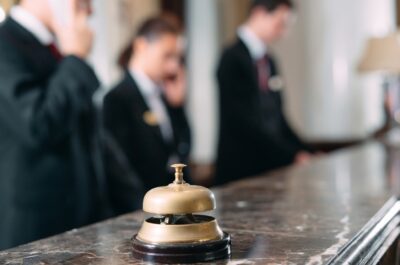
Hotel Maritim Berlin.
Compared with July 2015, Europe reported nearly flat occupancy (-0.4% to 76.7%). However, average daily rate was up 3.9% to EUR118.80, and revenue per available room increased 3.5% to EUR91.17. Africa experienced a 4.6% increase in occupancy to 56.9%, a 10.8% rise in ADR to US$103.42 and a 15.9% spike in RevPAR to US$58.89.
Hotels in the Middle East reported mixed results in July 2016, while hotels in Africa posted positive results in the three key performance metrics when reported in U.S. dollar constant currency, according to data from STR.
Compared with July 2015, the Middle East recorded a 4.8% rise in occupancy to 58.0%. However, average daily rate (ADR) was down 15.9% to US$161.82, and revenue per available room (RevPAR) fell 11.9% to US$93.88.
Africa experienced a 4.6% increase in occupancy to 56.9%, a 10.8% rise in ADR to US$103.42 and a 15.9% spike in RevPAR to US$58.89.
Performance of featured countries for July 2016 (local currency, year-over-year comparisons):
Kuwait recorded increases across the three key performance metrics: occupancy (+5.1% to 38.0%), ADR (+0.8% to KWD66.36) and RevPAR (+5.9% to KWD25.21). Performance was primarily driven by a 25.9% increase in occupancy in the Kuwait Area submarket. However, in the Kuwait City submarket, occupancy fell 3.8%.
Qatar reported decreases in each of the three metrics. Occupancy in the country fell 6.6% to 53.3%; ADR was down 0.8% to QAR491.68; and RevPAR dropped 7.3% to QAR261.93. According to STR analysts, the month’s performance was mostly affected by an 8.0% year-over-year increase in supply.
Tunisia posted a significant spike in both occupancy (+116.7% to 55.3%) and RevPAR (+100.1% to TND103.37), while the country’s ADR dropped 7.7% to TND187.00. In the comparable month from last year, Tunisia’s occupancy level was just 25.5% following the terrorist attack in Sousse the previous month. Despite the stark year-over-year percentage changes, the absolute occupancy level for July 2016 was actually the highest for any month in Tunisia since October 2014. STR analysts attribute the performance to security efforts in the country and campaigns focused on regaining tourism business. Lower rates also may have played a role in a 114.5% year-over-year increase in demand.
Performance of featured markets for July 2016 (local currency, year-over-year comparisons):
Beirut, Lebanon, saw a 7.3% increase in occupancy to 60.2%. However, ADR was down 12.8% to LBP234,510.72, and RevPAR dropped 6.4% to LBP141,258.21. The absolute occupancy level was the highest for a July in Beirut since 2011. The market’s ADR, however, has decreased year over year for all seven months in 2016, due in part to a 2.9% year-to-date increase in supply.
Dubai, United Arab Emirates, experienced increases in occupancy (+17.6% to 67.5%) and RevPAR (+7.5% to AED365.08), while ADR dropped 8.6% to AED540.60. The market’s demand was up 24.6% year over year with a lift from Eid al-Fitr festivities. At the submarket level, the highest absolute occupancy levels were reported in Jumeirah Palm & Beaches (74.9%) and the Deira & Airport Area (72.0%). ADR continues to be affected by new supply (+5.9% in July).
Johannesburg, South Africa, reported a 5.9% decline in occupancy to 59.2%, but an 8.7% rise in ADR to ZAR908.85 pushed RevPAR up 2.3% to ZAR537.74. The devaluation of the South African Rand has made the country an attractive tourist destination, and Johannesburg hoteliers have capitalized with increased rates, according to STR analysts. ADR has grown in year-over-year comparisons for 36 consecutive months. STR analysts cite political tensions prior to the 3 August elections as a reason behind lower occupancy for July 2016.
Europe hotel performance
Hotels in Europe recorded mostly positive results in the three key performance metrics when reported in euro constant currency, according to July 2016 data from STR. Compared with July 2015, Europe reported nearly flat occupancy (-0.4% to 76.7%). However, average daily rate was up 3.9% to EUR118.80, and revenue per available room increased 3.5% to EUR91.17.
Performance of featured countries for July 2016 (local currency, year-over-year comparisons):
Germany reported a 0.7% decrease in occupancy to 72.5%, but a 3.0% rise in ADR to EUR92.92 pushed a 2.3% increase in RevPAR to EUR67.38. Transient demand increased 4.9% in July, with notable growth in the Upscale segment (+13.5%).
Poland posted a 3.1% increase in occupancy to 77.3% as well as double-digit growth in ADR (+18.8% to PLN292.90) and RevPAR (+22.5% to PLN226.46). The top performing Polish markets were Poznan, with a 27.3% increase in occupancy, and Krakow, with a 42.0% increase in ADR. Poznan hosted the 24th World Congress of Political Science on 23-28 July. Krakow hosted World Youth Day on 25-31 July.
Portugal recorded a 2.8% rise in occupancy to 83.4% along with double-digit increases in ADR (+10.7% to EUR121.89) and RevPAR (+13.9% to EUR101.66). Hotels in the Upper Midscale class posted the strongest growth levels, with a 6.0% increase in occupancy and a 13.5% rise in ADR.
Performance of featured markets for July 2016 (local currency, year-over-year comparisons):
London, England, reported its first month of the year with noticeable RevPAR growth (+4.0% to GBP137.19). The market recorded nearly flat occupancy (+0.1% to 88.2%) but an increase in ADR (+3.8% to GBP155.47) helped by the 2016 Wimbledon Championships (27 June to 10 July) and the biennial Farnborough International Airshow (11-17 July). The Luxury class was the top performing segment (RevPAR +8.1%) for the month.
Madrid, Spain, experienced a 2.0% drop in occupancy to 65.4%, but a 4.4% rise in ADR to EUR90.06 drove RevPAR up 2.3% to EUR58.89. STR analysts note that Transient demand was up 13.9%, while Group demand declined 16.5%. The Spanish capital also reported a 12.7% increase in Luxury class hotel supply, which dented the Luxury segment’s occupancy (-13.9%).
Prague, Czech Republic, saw a 0.5% dip in occupancy to 88.8%. However, ADR was up 4.8% to CZK2,051.73, and RevPAR rose 4.3% to CZK1,821.87. The overall performance growth was largely due to the Midscale and Economy segment, which experienced a 9.3% increase in RevPAR.
Rome, Italy, reported decreases in occupancy (-2.5% to 80.8%) and RevPAR (-1.0% to EUR126.14). ADR in the market was up 1.5% to EUR156.11.
Central/South America hotel performance
Hotels in the Central/South America region recorded mixed results in the three key performance metrics when reported in U.S. dollar constant currency, according to July 2016 data from STR.
Compared with July 2015, the Central/South America region reported a 4.9% decrease in occupancy to 56.7%. Average daily rate (ADR), however, increased 10.1% to US$89.84, and revenue per available room (RevPAR) grew 4.7% to US$50.93.
Performance of featured countries for July 2016 (local currency, year-over-year comparisons):
Ecuador reported decreases across the three key performance metrics. The country’s occupancy fell 13.0% to 59.4%; ADR was down 6.8% to US$97.20; and RevPAR dropped 18.9% to US$57.76. According to STR analysts, Ecuador’s economy is heavily dependent on the oil industry. With crude oil prices down, and Ecuador being the only fully dollarized South American market, the country has become less competitive for exports compared with neighboring nations like Colombia and Peru. The pair of earthquakes that hit the country’s coast on 11 July also affected performance.
Panama experienced increases in occupancy (+5.0% to 51.6%) and RevPAR (+1.4% to PAB49.22), whereas ADR dropped 3.4% to PAB95.36. Occupancy has increased year over year for six of the seven months in 2016, while ADR has decreased in five of the seven months. STR analysts believe that the country has become a more attractive tourist destination, as evidenced by a 6.0% year-to-date increase in Transient demand and a 2.9% rise in Group demand.
Peru recorded nearly flat occupancy (+0.2% to 65.8%) as well as increases in ADR (+5.2% to PEN442.12) and RevPAR (+5.4% to PEN290.94). The absolute occupancy followed a trend of the last several months, while the rise in ADR is likely due to a 5.6% demand increase in the Luxury and Upper Upscale segments.
Performance of featured markets for July 2016 (local currency, year-over-year comparisons):
In the month prior to hosting the Summer Olympics, Rio de Janeiro, Brazil, saw a 17.4% drop in occupancy to 48.2%. However, a 21.0% rise in ADR to BRL477.62 kept RevPAR flat at BRL230.07. STR analysts believe that the month’s performance was consistent with the approach of the Olympics.
Sao Paulo, Brazil, reported decreases across the three key performance metrics: occupancy (-0.3% to 58.4%), ADR (-3.9% to BRL297.36) and RevPAR (-4.2% to BRL173.69).
Rosario, Argentina, posted nearly flat occupancy (+0.3% to 66.9%) but a significant spike in both ADR (+48.9% to ARS1,169.57) and RevPAR (+49.3% to ARS782.02). While the market’s occupancy remained flat, ADR increased significantly due to the devaluation of the Argentine Peso and inflation.
Theodore is the Co-Founder and Managing Editor of TravelDailyNews Media Network; his responsibilities include business development and planning for TravelDailyNews long-term opportunities.


































































































































